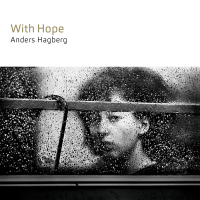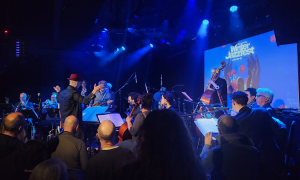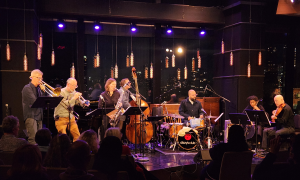Home » Jazz Articles » Live Review » Festival Jazz International Rotterdam 2018
Festival Jazz International Rotterdam 2018

LantarenVenster
Rotterdam
October 26-28, 2018
As a jazz enthusiast strolling along the beautiful waterfront of Rotterdam, encountering the name Van Gelder almost seems too good to be true. Even though in this case, the name is found on a truck and refers to a corporation that sells fruit and not the famous jazz engineer Rudy van Gelder of Blue Note fame. However, Rotterdam is truly a jazz city, and this is underlined not only by the highly profiled North Sea Jazz Festival, but also by the Festival Jazz International Rotterdam.
Rotterdam is the second largest city in the Netherlands and its status as Europe's largest port with an ideal location by the North Sea has resulted in names such as Gateway to Europe and Gateway to the World. The openness of the city was also reflected by the program of this year's festival curated by Frank van Berkel. Whereas a big part of the attraction of North Sea Jazz Festival is to get a package deal to hear hot and established names that are already mainstays in the festival circuit, Festival Jazz International Rotterdam plays it less safe. A festival can be a pleasant way of confirming the familiar, but it can also lead to new roads and discoveries. This is what Festival Jazz International Rotterdam does.
The concerts all took place at LantarenVenster whose history as a place for dance, theater, movies and music goes back to 1949. It was originally located at Gouvernestraat, but in 2010 changed to its present location at Wilhelminapier. The dual identity as a place for cinema and music was also reflected in the program that both included concerts and two screenings of jazz related films: the classic sci-fi blaxploitation movie Space is the Place from 1974 starring Sun Ra and his Arkastra and a new Dutch biopic about the last days of trumpeter Chet Baker called My Foolish Heart.
The overall theme of the festival was the voice and it was a suitable umbrella to explore different aspects of the human voice as expressed through vocal cords and instruments. Instead of feeling forced, the theme functioned as a lens that illuminated the many ways the musical voice can be used. However, even though Mischa Andriessen's fine article about the voice found in the festival program pointed out the link between jazz and the quest for the personal voice, the emphasis was not on the pure solo voice, not a single solo recitation was found in the program, but rather the interplay between voices in smaller or larger groups ranging from intimate duos to elaborate orchestras.
Voices of Protest
One of the ways in which the voice expressed itself at the festival was in songs of protest. Such songs can come in many shapes and forms and the protest songs at the festival were subtler than the typical political song. Instead it was about providing a new perspective that could give food for thought. Romanian singer Suzana Lașcu, who opened the festival, questioned the norms of society in a song like "Just let the woman be sad" with the line "don't force woman to smile." The music was seeking to expand established genres and a song introduced as a ballad did not fit the conventions of the form. Lascu and her band, Crusaders vs. Hurricanes, created an expression somewhere between jazz, pop and art-rock. Especially the expressive playing of guitarist Jorrit Westerhof contributed to the energy as his hair was swirling around during a guitar solo.The Norwegian trio, Gurls, also challenged clichés and conventions and swept the audience away with their minimalistic soulful jazz pop. They supplemented each other perfectly. Rohey Taalah as the charismatic singer, Hanna Paulsberg with her elegant ornaments on the saxophone and tight funky playing, and bassist Ellen Andrea Wang with her breathy background vocals and superb groove. Their song "Syngedame" (singing lady) turned the male clichés of the pop world around with lyrics that told of the girls cruising around in a car and experiencing screaming boys at their concerts. In fact, they did bring one of the boys, drummer Elias Taffjord, for some of the concert and he fitted the sound perfectly, but it was the three girls that commanded the stage with presence, storytelling, sophisticated playing and pure girl power.
As opposed to Suzana Lascu and Gurls, the sound of Vera van Der Pool Band was following the pattern of the classic singer/songwriter, but the use of upright bass was a refreshing touch. Guest trumpeter Jan van Duikeren also added a solid dose of jazz atmosphere to a sound related to the eclectic Americana aesthetic found on Anthem (2018), the latest album by Madeleine Peyroux.
If Suzana Lascu and Gurls questioned norms and Vera van Der Pool told stories through music, saxophonist Donny McCaslin and his band with singer and guitarist Jeff Taylor played an anthem for a new way of seeing the world, "A New Kindness." Since his collaboration with David Bowie, McCaslin has moved even more into a rock-influenced song direction and while his new sound may open doors for a wider audience some of the sophistication has also been lost in translation. At times his rock aesthetic came across as rather bombastic, but there were also fine and mellow moments.
While McCaslin's protest was an anthem for a new kindness in the familiar world, harpist and singer Laura Perrudin created an alternative dream world with her tender universe where a song could be seen from the perspective of a cloud. There were also suggestions of unsettling moods and Perrudin used her harp to convey a varied palette of sounds and sometimes layered her voice to sing a celestial duet with her own voice. The poetic quality of her universe was underlined when she ended her second set with an interpretation of a William Blake poem with the famous lines: To see a World in a Grain of Sand / And a Heaven in a Wild Flower / Hold Infinity in the palm of your hand /And Eternity in an hour.
New Voices in the Spotlight: Wietse Voermans and Vuma Levin
A big part of the joy of going to a festival is the discovery of new names. The music of talented saxophonist Wietse Voermans proved to be one of the highlights of the festival. Voermans played a concert with Spoken +2, a constellation with four horns, drums, voice and electronics, but he was also the leader of The Pack Project, an initiative from the festival to highlight young jazz talent. In collaboration with the festival, Voermans had put together a group with Michael Moore - Clarinet on saxophone and clarinet, Rasmus Svale Kjærgaard Lund on tuba, Alessio Bruno on bass and Onno Govaert on drums. Together the group moved through free compositions that both had the clear structure of refined pieces and the freedom and space of improvisation. Each composition was a field of possibilities without any interpretation given by a title. Voermans laconically introduced each composition as composition number one, composition number two and so forth. It was especially a joy to hear the fine textures of the instruments where the tuba took the role of the bass. Voermans' approach recalled the free chamber music of Jimmy Giuffre and like Giuffre he can swing.The same attention to the hushed details of instruments in combination with lovely melodic lines also came to the fore in the group Spoken. It was a genuine conversation between instruments and not just four horns blowing. Again, each saxophonist challenged the sound of the instrument and especially Ruben Verbruggen's playing on the heavy baritone saxophone was fascinating as he made the horn sing like a flute. An important addition to the line-up with four horns was the drummer Jelle van Giel who added an extra dynamic layer of rhythm. Singer Sanne Huijbregts also lifted the music with her voice aided by the use of a loop-station. The use of electronics was subtle and did not disturb the clarity of the instruments. To show their ties with tradition, the group also played a memorable arrangement of Thelonious Monk's "Round about Midnight."
Inspired by the recommendable AAJ-article on guitarist Vuma Levin written by Seton Hawkins, I had looked forward to hearing his concert, which was also the last concert of the festival. However, the noisy crowd in the foyer ruined the fine melodic textures of Levin's music and the elaborate development of his suites. The volume was also too high, perhaps a reaction to the general volume of the audience, among them some people up front who seemed more occupied by talking than listening. In general, it is always a tough sell to play in a place like the foyer. The choices that had been made functioned well and fitted the occasion with acts influenced strongly by rock, pop, punk, folk and funk. Levin was the purest jazz act playing in the foyer and consequently his music suffered from the circumstances. Hopefully he will be given a chance to play the festival again in one of the two auditoriums that made up the other venues of the festival.
Old Voices in the Spotlight: Rob Franken and Chet Baker
While the festival is aimed at the public, it also hosts an international meeting of industry professionals, who are invited to attend the festival. The collaboration between Britain and the Netherlands is close. Thus, a day was dedicated to a conference with enlightening talks and discussions, including a presentation by Steve Mead from Manchester Jazz Festival. He presented an overview of the British scene and gave tips on how to approach festivals and venues. During the festival, there was also time for less business-related presentations. Journalist, radio documentarist, DJ, producer and label owner, Frank Jochemsen, gave a fascinating talk about the Dutch musician Rob Franken, a pioneer of the Fender Rhodes and other electric instruments, who recorded a feast of funky music that Jochemsen has helped bringing to the public by releasing it on the label 678 Records that he runs with Sander Huibers. So far, they have released six records: Six Seven Eight, Colours & Images, Don't Stop, Blue Sky Fingers, Absorbed Love and Together.In his talk, Jochemsen included concert clips and an interview with Toots Thielemans whom Franken helped rejuvenate with his approach to improvisation and composition. Several pictures were also shown, and the most touching moment was when it was revealed that Franken's own family attended the talk. Jochemsen promised to release more of Franken's music from the vaults and a tribute concert is also in the making with some of Franken's old sidemen.
While Rob Franken is a Dutch pioneer that deserves more recognition, trumpeter Chet Baker has already been canonized long time ago. Those wanting a less troubling image of the artist should not watch Rolf van Eijk's movie My Foolish Heart. It delves into Baker's fight with his own demons that led him to hurt and abuse other people, especially those closest to him. Told in a poetic neo-noir style, the movie juxtaposes the events leading to Baker's death with the investigation done by a flawed policeman who turns out to be just as troubled by his own demons as Baker was. In the middle of it all, there is the music, impossibly beautiful, played by a man who was all too human and sunk to the lowest depths of destruction.
Cosmic and Funky Voices
It is hard to confront the contradictions of Chet Baker, but fortunately the festival also delivered positive energy that lifted up the spirit. Trumpeter Theo Crooker played with his quintet and combined the tight swinging of jazz with the sound of organic funk, soul and hip hop. Trumpeter Josef Leimberg was also funky, but more spiritual in his approach that changed between meditative moments with rattling percussion, ethereal guitar playing, swampy grooves and stirring saxophone playing, including a John Coltrane recitation from saxophonist Tracy Wanname.Trombone-player Efe Erdem also had the funk and while he did not get as deep as Crooker or Leimberg, he started a party in the foyer and showed himself as a serious competitor to Nils Landgren. Things got even better when guest vocalist, Lady Shaynah, entered the scene. In fact, things got so funky that a guy in the audience started tapping his glass to the rhythm of the music. As an extra treat, the band played a cover version of Al Green's "Let Stay Together" and there was a feeling that no one really wanted to leave the party that Erdem had started.
A Meeting of Many Voices
The ultimate embodiment of the theme of the voice came in the shape of Andreas Schaerer, who showed himself as the true heir of Bobby McFerrin with a voice that could do almost everything. He both played in duo with guitarist Anton Goudsmit and as a special guest featured with the New Rotterdam Jazz Orchestra. Without any problems he played a "trombone" duet with the regular trombonist Louk Boudesteijn and conveyed a rainforest of sounds. He was also a one man beat box and at one point took the role of the leader to do some slap stick conducting to treat the big band as his very own sound machine.The possibilities of working with many musical voices were also explored in the concert with The Chronometer's Orchestra. Guitarist and conductor Zacharias S. Falkenberg wore a t-shirt with art-rock band Sonic Youth. It said something about the unconventional approach of the orchestra. The music explored many different contrasts ranging from powerful blowouts to a subtle piece for string quartet. One of the highlights of the concert was the appearance of singer Greetje Bijma who was given a chair when she entered the scene. This became the natural starting point for an improvisation where she sang: "thank you for giving me this chair." No one really took a backseat during the concert and Bijma also ended up walking on the scene, restlessly exploring new musical sensations as the rest of the orchestra.
Saxophonist Ben Wendel also worked with many different voices, but many of them were not present. His latest album, The Seasons, is an homage to twelve different musicians that have meant something to him. For the concert, he brought his band with pianist Sullivan Fortner, bassist Joe Martin, drummer Kendrick Scott and guitarist Gilad Hekselman. Hekselman is actually the subject of the composition "October" and so it was fitting that he was present. His lyrical virtuosity and ability to create complex soundscapes enriched the concert, but it was especially the style of Fortner that was an experience as he changed between elegant embellishments, chordal landscapes and bluesy figures. More than anything, the concert was a good example of a tightknit jazz group doing their thing. However, it could have been interesting to hear the whole suite instead of just selections, but the pieces were stretched to the point where this became impossible. Too many solos and the coherence of the suite was lost, but the playing was electrifying.
The Voice of the Duo: Sanem Kalfa & George Dumitriu
It was impressive to witness the complex interplay between many musical voices in the large ensembles, and the pure virtuosity of the voice shone bright in the rhythmic ramblings of Andreas Schaerer, but the most convincing testimony to the power of the musical voice came in the modest form of a duo. Singer Sanem Kalfa and violinist and guitarist George Dumitriu have played together for a long time, in fact since they were eleven years old as the audience was told, and their musical empathy carried a concert that moved through deep emotional landscapes ranging from subtle spherical details to expressionistic cries.The duo played songs from their album Dance where they as collectors of songs in the folk tradition have found songs by Antonio Carlos Jobim, Mattia Magatelli and Tom Ze, but unlike folklorists, who preserve the sounds of the past, Kalfa and Dumitriu take the songs into the present and imbue them with their own poetic stamp. In other words, they find the essence or personality of the song as they see it. They also write their own songs in dialog with lyrics. The Persian poet Rumi's words find a way into their universe as they reveal his musical poetry. One of the highlights of the concert was the title track where the duo spun themselves into greater heights of intensity like whirling dervishes. However, it would really be wrong to speak of highlights in a concert that formed a balanced narrative encompassing acoustic and electric sounds, borrowed and original songs, screams and silence, beauty and despair, tradition and renewal. With their dialog with each other, the audience, and the music of the past and the present, Kalfa and Dumitriu's concert carried an uplifting message that could be the credo of the festival: the musical voice, no matter how it speaks, is able to bring us closer together as human beings.
Photo Credit: Sophie Conin
Tags
Live Reviews
Jakob Baekgaard
Netherlands
Rotterdam
Sun Ra
Chet Baker
Suzana Lascu
Jarrit Westerhoff
Rohey Taalah
hanna paulsberg
Ellen Andrea Wang
Elias Taffjord
Vera van Der Pool
Jan van Duikeren
madeleine peyroux
Don McCaslin
Jeff Taylor
Laura Perrudin
Wietse Voermans
Michael Moore
Rasmus Svale Kjærgaard Lund
Alessio Bruno
Onno Govaert
Jimmy Giuffre
Sanne Huijbregts
Thelonious Monk
Vuma Levin
Seton Hawkins
Rob Franken
Toots Thielemans
Theo Crooker
Josef Leimberg
John Coltrane
Tracy Wanname
Efe Erdem
Nils Landgren
Lady Shaynah
Andreas Schaerer
Bobby McFerrin
Anton Goudsmit
Louk Boudesteijn
Zacharias S. Falkenberg
Greetje Bijma
Ben Wendel
Sullivan Fortner
Joe Martin
Kendrick Scott
Gilad Hekselman
Sanem Kalfa
George Dumitriu
Antonio Carlos Jobim
Mattia Magatelli
Tom Zé
PREVIOUS / NEXT
Support All About Jazz
 All About Jazz has been a pillar of jazz since 1995, championing it as an art form and, more importantly, supporting the musicians who make it. Our enduring commitment has made "AAJ" one of the most culturally important websites of its kind, read by hundreds of thousands of fans, musicians and industry figures every month.
All About Jazz has been a pillar of jazz since 1995, championing it as an art form and, more importantly, supporting the musicians who make it. Our enduring commitment has made "AAJ" one of the most culturally important websites of its kind, read by hundreds of thousands of fans, musicians and industry figures every month.




























